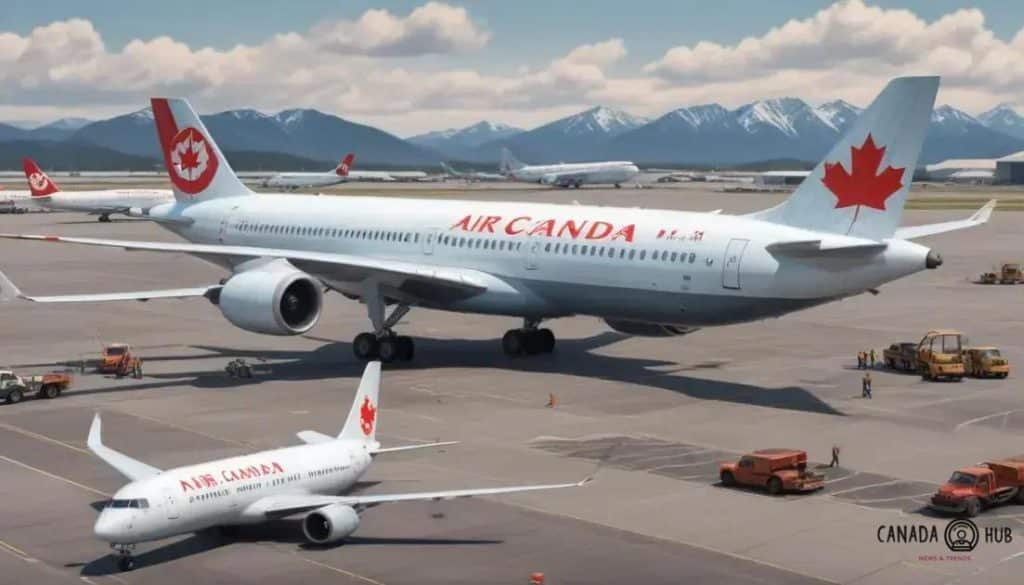CIRB back to work order Air Canada: Impact, Updates and What Travelers Need to Know

The CIRB back to work order Air Canada has become a turning point in one of the airline’s most challenging labor disputes. It not only compels employees to return but also raises big questions about rights, negotiations, and the future of air travel in Canada.
For travelers, the decision means fewer cancellations and a more predictable schedule, but it also highlights the tension behind the scenes. Understanding these dynamics helps you see why your journey is directly linked to labor relations.
If you’ve been wondering what this order really means, you’re not alone. From worker compliance to passenger impact, this story is shaping the way Canada’s largest airline moves forward. Ready to break it down?
Understanding the CIRB process
The CIRB back to work order Air Canada is not just a legal directive; it represents one of the most powerful tools available to the Canadian Industrial Relations Board when labor disputes threaten essential services.
The CIRB, an independent tribunal, is responsible for balancing the rights of workers with the need to maintain public services like air travel. Its role becomes especially important when strikes or lockouts disrupt the operations of major carriers.
When a back-to-work order is issued, it typically follows a breakdown in negotiations where mediation fails to reach a settlement.
In August 2025, for example, the CIRB was authorized by the federal government to impose such an order on Air Canada flight attendants after they began a strike that canceled hundreds of flights daily.
According to Reuters, this directive required all employees to return to work by a set deadline while the unresolved issues moved to binding arbitration.
The CIRB process usually unfolds in several stages. It begins with the filing of a complaint or notice by one of the parties, followed by investigation and mediation led by the Board. If the conflict cannot be resolved, the CIRB may then issue a formal back-to-work order.
Beyond simply ordering compliance, the CIRB also provides legal frameworks and standards that guide future labor relations, shaping how negotiations between unions and employers evolve across the aviation industry.
Impact on Employees and Management
The implications of the CIRB back to work order Air Canada go far beyond a return to normal flight schedules. For employees, these orders can mean immediate changes to their working conditions.
Flight attendants, for instance, have raised concerns about fair compensation for “ground time”, the hours spent preparing flights and assisting passengers before takeoff.
Although part of these demands was included in a tentative agreement, the wage proposal was overwhelmingly rejected by over 99% of union members in September 2025, according to The Maple.
From management’s perspective, complying with CIRB rulings often requires operational adjustments, such as reorganizing schedules, reallocating resources, and implementing new protocols.
While the orders ensure that flights resume, they also highlight deeper tensions between labor rights and the financial stability of the airline.
As AP News reports, the unresolved wage dispute is now subject to mediation and, if necessary, arbitration, demonstrating how management must adapt to a structured legal process that limits unilateral decisions.
The broader impact of these rulings is the fostering of long-term communication channels between employees and management. By forcing both sides into arbitration or mediation, the CIRB creates opportunities for dialogue that might not otherwise occur.
This structured environment may lead to more stable working conditions and could reduce the likelihood of disruptive strikes in the future.
For Air Canada, it also sets a precedent on how labor conflicts will be handled in a highly regulated industry, shaping not only current disputes but also the framework of negotiations to come.
Impact on Air Canada employees
The CIRB back to work order Air Canada has a direct and profound impact on flight attendants and other staff, since it requires them to return to work under conditions that may not have been fully negotiated.
For many, this sudden shift means adapting to new rules, tighter schedules, and an environment shaped by arbitration rather than voluntary agreements. The process can feel restrictive, but it also brings clarity by ensuring that work resumes and employees receive structured guidance.
Employees often experience disruptions to their work-life balance, as shifts can be reassigned quickly to cover canceled flights and meet operational demands. Longer duty hours, irregular rosters, and unexpected schedule changes are common outcomes.
At the same time, the order creates opportunities for employees to engage in more structured communication with management, which can lead to better-defined responsibilities and expectations over time.
Key Changes for Employees
The most immediate effects of the CIRB back to work order Air Canada are seen in the day-to-day operations of staff. Some of the most relevant changes include:
-
Schedule Adjustments: Employees may face longer shifts or altered rosters to make up for lost flights during the strike, impacting personal routines.
-
Performance Communication: Management typically increases oversight and feedback, requiring staff to align closely with new standards and expectations.
-
Training Opportunities: To adapt to procedural changes, employees may receive additional workshops on customer service, safety, and updated protocols introduced during the arbitration period.
-
Collective Adaptation: Adjusting together fosters solidarity, where employees rely on teamwork to handle increased workloads and operational pressure.
These elements bring both challenges and growth opportunities. Workers who embrace flexibility and remain open to retraining often find themselves better prepared for long-term changes in the airline’s structure.
Support Resources for Employees
To ease the transition, Air Canada has highlighted support mechanisms for its workforce during the enforcement of the CIRB back to work order Air Canada.
Such measures are designed to maintain morale and safeguard employee well-being, particularly after the stress of a strike.
-
Employee Assistance Programs (EAPs): Confidential counseling and support services for mental health, family stress, and workplace challenges.
-
Workshops and Stress Management: Sessions focused on adaptability, resilience, and coping strategies for high-pressure environments.
-
Transparent Updates: Regular communication from leadership helps reduce uncertainty, providing clarity about schedules, arbitration progress, and expected outcomes.
-
Union Support Channels: CUPE continues to offer guidance, ensuring employees remain informed of their rights during the arbitration process.
By using these resources, employees can navigate the changes more smoothly, building resilience while maintaining a sense of stability.
The structured support also reinforces trust that, even under external directives, the airline recognizes the importance of its workforce’s well-being.
What to expect for travelers

For travelers, understanding the implications of the CIRB back to work order Air Canada is essential, as the directive directly shapes flight schedules and the overall travel experience.
When the Board mandates employees to return, the immediate goal is to stabilize operations after days of cancellations and uncertainty. This can bring relief for passengers, but it also introduces a transitional period where the airline adjusts its services and resources to meet renewed demand.
One of the most noticeable impacts for customers is the adjustment in flight schedules. Following the strike, Air Canada has had to reorganize departures, sometimes adding flights to popular routes to recover from the backlog.
Travelers may see both increased frequency on certain destinations and temporary changes in departure times, all aimed at restoring reliability. The return of staff also supports better customer service, as crews are reassigned to handle higher volumes of passengers with more efficiency and care.
Beyond scheduling, Air Canada continues to focus on health and safety measures during this transition. The CIRB back to work order Air Canada obliges the company not only to resume service but also to reassure passengers of a safe travel environment.
Updated boarding protocols, enhanced cleaning routines, and clearer guidance at airports are part of this renewed commitment.
For travelers, staying informed through official channels like the Air Canada app or website is vital, since communication is a key priority for the airline as it navigates the aftermath of the labor dispute.
Recent updates and announcements
Keeping track of the latest developments around the CIRB back to work order Air Canada has been vital throughout September 2025.
After the order was enforced in mid-August, operations gradually returned to normal, but the impact of the labor dispute continues to shape announcements from both the airline and the Canadian Union of Public Employees (CUPE).
Early in September, flight attendants overwhelmingly rejected the wage proposal included in the tentative agreement, with more than 99 percent voting against it.
This rejection, reported by The Maple, showed that although the back-to-work order restored service, the core issues around pay remain unresolved and have moved into mediation.
For employees, these updates have meant preparing for arbitration on wage disputes while adapting to new conditions included in the earlier agreement, such as payment for ground duties.
For travelers, the announcements have focused on stabilizing schedules, restoring canceled flights, and improving service after weeks of disruption.
Air Canada has stated publicly that its priority is to regain customer confidence, emphasizing operational reliability and stronger communication with passengers.
Key Updates to Watch For
Since the enforcement of the CIRB back to work order Air Canada, the airline has been issuing announcements that directly affect both daily operations and customer expectations.
Schedule adjustments have been frequent, with some routes expanded to meet pent-up demand and others reorganized to balance crew availability.
These measures aim to prevent further large-scale cancellations like those seen in August, when hundreds of flights were grounded.
The return of flight attendants under the CIRB directive has also allowed Air Canada to strengthen customer service, promising shorter wait times and more consistent in-flight support.
Another area of updates involves safety and health protocols. While Canada is no longer under the intense restrictions of past years, Air Canada has continued to adapt procedures in airports and cabins to reassure travelers during this period of heightened attention.
Clearer boarding processes and communication about delays have become central to its announcements, helping reduce frustration and confusion.
By using its website, app, and direct notifications, the airline ensures that customers are kept informed about changes to their itineraries and any new requirements they might face when traveling.
Engagement with Customers
One of the strongest themes emerging from September 2025 is Air Canada’s renewed focus on customer engagement. The CIRB back to work order Air Canada not only compelled a return to operations but also pressured the airline to rebuild trust with a public that endured widespread cancellations.
To meet this challenge, Air Canada has stepped up its communication strategy. Official statements, frequent press releases, and social media updates now play a central role in keeping passengers informed.
This approach goes beyond information—it aims to reassure travelers that the airline is stable and responsive after a turbulent summer.
Newsletters, website announcements, and enhanced digital tools within the Air Canada app are designed to provide clarity about schedules, service improvements, and the progress of mediation with CUPE.
For passengers, staying connected with these updates offers peace of mind, while for the airline, it represents a necessary step toward repairing its reputation and showing that it can deliver reliable service even under the scrutiny that followed the CIRB’s intervention.
FAQ – Frequently Asked Questions about the CIRB Order
What is a CIRB back to work order?
A CIRB back to work order mandates that employees return to work following a labor dispute, ensuring normal operations resume.
What should employees do if they have concerns about the order?
Employees should reach out to their HR department for guidance and clarification on how the order affects their roles.
How will the CIRB order impact travel plans for customers?
Travelers can expect adjustments in flight schedules and enhanced customer service as airlines adapt to new operational protocols.
Where can I find updates on Air Canada’s policies?
Air Canada provides updates through their official website, app, and customer communications, keeping travelers informed about any changes.





